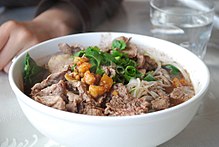| Revision as of 14:40, 4 January 2025 editPaul 012 (talk | contribs)Autopatrolled, Extended confirmed users, Pending changes reviewers80,153 edits Added {{AI-generated}} tagTag: Twinkle← Previous edit |
Revision as of 15:37, 4 January 2025 edit undoPaul 012 (talk | contribs)Autopatrolled, Extended confirmed users, Pending changes reviewers80,153 edits Removing AI-generated nonsense with false references copied from becommon.co.Next edit → |
| Line 33: |
Line 33: |
|
| vi = Hủ tiếu |
|
| vi = Hủ tiếu |
|
}} |
|
}} |
|
|
|
|
'''Kuai Tiao Thai''' ({{langx|th|ก๋วยเตี๋ยวไทย}}, {{RTGS|''kuaitiao thai''}}) is a ]<ref>สุกัญญา สุจฉายา. อาหารไทยสมัยกรุงศรีอยุธยา. วารสารมนุษยศาสตร์ปีที่ 24 ฉบับที่ 2, กรกฎาคม-ธันวาคม 2560</ref> ] eaten in ],<ref>ม.ร.ว.คึกฤทธิ์ ปราโมช, 2490. สี่แผ่นดิน</ref> Known for its versatility, affordability, and rich flavors. |
|
|
|
|
|
== Origin == |
|
|
The history of Kuai Tiao Thai can be traced back to the influence of Chinese immigrants in Thailand during the ] period (1350–1767). Chinese traders brought their culinary traditions, including noodle-making techniques, to the region. Over time, these influences were adapted and integrated with local Thai ingredients and flavors. |
|
|
|
|
|
] (reigned 1910–1925) is often credited with popularizing Kuai Tiao Thai as a street food. During his reign, the dish became a practical solution to urbanization and the need for quick, affordable meals. |
|
|
===Types of Kuai Tiao in Thailand=== |
|
|
|
|
|
* {{lang|th|ก๋วยเตี๋ยวเรือ}} (Kuai Tiao Reua): Known as "]," this dish originated from vendors who sold noodles from boats along canals. The broth is often made with a combination of pork or beef blood, spices, and dark ]. It’s typically served in small portions to mimic its original preparation on boats. |
|
|
|
|
|
* {{lang|th|ก๋วยเตี๋ยวต้มยำ}} (Kuai Tiao Tom Yum): This variation incorporates the Thai ] flavors of spicy, sour, and tangy. It often includes lime juice, chili flakes, peanuts, and sometimes a touch of sugar. |
|
|
|
|
|
* {{lang|th|ก๋วยเตี๋ยวเย็นตาโฟ}} (]): Yen Ta Fo has bright pink broth, flavored with ]. This dish is often served with ]s, ]. |
|
|
|
|
|
* {{lang|th|ก๋วยเตี๋ยวแห้ง}} (Kuai Tiao Haeng): This dry noodle dish is served without broth. Instead, it’s mixed with seasonings such as soy sauce, garlic oil, and chili, often accompanied by a side of soup. |
|
|
|
|
|
* {{lang|th|ก๋วยเตี๋ยวสุโขทัย}} (]): Originating from the ] province, this dish has a sweet and tangy flavor. It includes thin rice noodles, ground pork, green beans, and peanuts, often garnished with lime and fresh herbs. |
|
|
|
|
|
* {{lang|th|ก๋วยเตี๋ยวลูกชิ้นปลา}} (Kuai Tiao Look Chin Pla): Fish ball noodles are a lighter option, featuring clear broth and handmade fish balls. |
|
|
|
|
|
* {{lang|th|ก๋วยเตี๋ยวเป็ด}} (Kuai Tiao Ped): Duck noodle soup features braised duck, spices, and sometimes medicinal herbs. |
|
|
|
|
|
=== Key ingredients and noodle varieties === |
|
|
The foundation of Kuai Tiao Thai lies in its noodles, which come in various forms: |
|
|
|
|
|
* {{lang|th|เส้นเล็ก}} (Sen Lek): Thin rice noodles |
|
|
* {{lang|th|เส้นใหญ่}} (Sen Yai): Wide rice noodles |
|
|
* {{lang|th|บะหมี่}} (Ba Mee): Egg noodles |
|
|
* {{lang|th|วุ้นเส้น}} (Woon Sen): Glass noodles made from ] starch |
|
|
|
|
|
Common toppings include sliced meats (pork, chicken, beef, or duck), fish balls, tofu, and vegetables like bean sprouts and morning glory. Broths are often enriched with aromatic herbs, spices, and condiments such as fish sauce, vinegar, and chili flakes, allowing diners to customize their bowls to taste.<ref>โรม บุนนาค. รัฐนิยมของจอมพล ป. เมื่อไทยจะเป็นมหาอำนาจ. เรื่องเก่าเล่าปัจจุบัน</ref><ref>ชาติชาย มุกสง. 2475 กับการปฏิวัติรสชาติอาหาร : จากการกินเพื่ออยู่สู่การกินพื่อชาติและการต่อสู้ทางวัฒนธรรมของรสชาติในสังคมไทยร่วมสมัย. จาก ๑๐๐ ปี ร.ศ.๑๓๐ ถึง ๘๐ ปีประชาธิปไตย</ref> |
|
|
|
|
|
|
== References == |
|
== References == |
